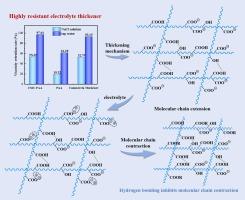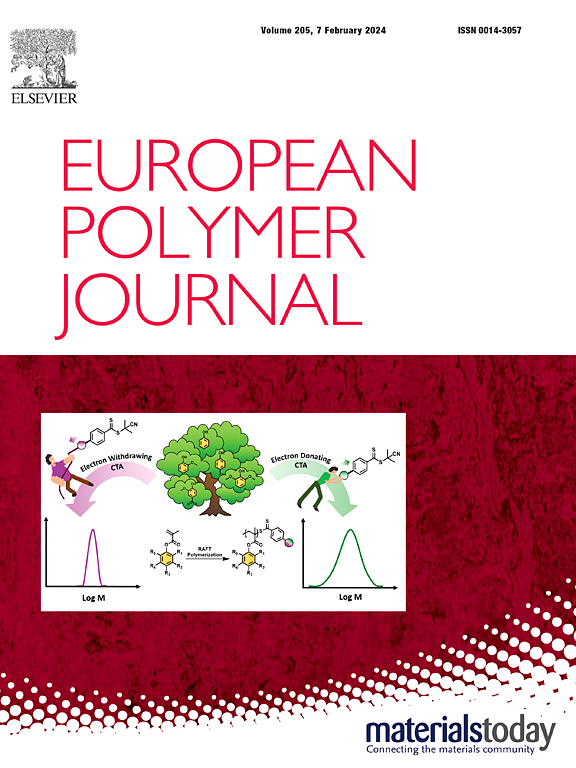Synthesis and rheological properties of carboxymethyl cellulose modified polyacrylic acid thickener with high electrolyte resistance
IF 5.8
2区 化学
Q1 POLYMER SCIENCE
引用次数: 0
Abstract
Herein, a method for preparing highly resistant electrolyte thickeners by introducing supramolecular interactions (multiple hydrogen bonds and electrostatic interactions) and chemical crosslinking during the polymerization of acrylic monomers has been proposed. The hydroxyl group on the carboxymethyl cellulose (CMC) unit provides multiple hydrogen bonds for the thickener structure, the carboxyl group on the polyacrylic acid (PAA) molecular chain provides electrostatic interactions for the thickener structure, and the crosslinking agent MBA forms a chemical network structure in the CMC-PAA molecular chain. The synergistic formation of multiple dynamic crosslinking points through the above effects is beneficial for improving the electrolyte resistance of CMC-PAA thickeners. The shift of the carbonyl characteristic peak on the FTIR spectrum confirms the existence of hydrogen bonding interactions between PAA and CMC. The viscosity retention rates of CMC-PAA thickener in tap water and saltwater electrolytes were 97.01% and 53.22%, respectively, exceeding our previously reported hydrophobic modified polyacrylic acid thickener, confirmed that the introduction of hydrogen bonds inhibits the contraction of molecular chains. The fitting analysis of the rheological properties of the color paste shows that the sisko model has high fitting accuracy of the color paste. In addition, CMC-PAA has excellent thermal stability and water-holding properties, which can ensure the contour clarity of subsequent inkjet printed fabrics. This study provides a new method for improving the electrolyte resistance of polyacrylic acid thickeners.

高抗电解质性羧甲基纤维素改性聚丙烯酸增稠剂的合成及其流变性能
本文提出了一种在丙烯酸单体聚合过程中引入超分子相互作用(多个氢键和静电相互作用)和化学交联来制备高抗电解质增稠剂的方法。羧甲基纤维素(CMC)单元上的羟基为增稠剂结构提供了多个氢键,聚丙烯酸(PAA)分子链上的羧基为增稠剂结构提供了静电相互作用,交联剂MBA在CMC-PAA分子链上形成了化学网络结构。通过上述作用协同形成多个动态交联点,有利于提高CMC-PAA增稠剂的耐电解质性能。羰基特征峰在FTIR光谱上的位移证实了PAA与CMC之间存在氢键相互作用。CMC-PAA增稠剂在自来水和盐水电解质中的粘滞率分别为97.01%和53.22%,超过了我们之前报道的疏水改性聚丙烯酸增稠剂,证实了氢键的引入抑制了分子链的收缩。对色浆流变特性的拟合分析表明,sisko模型对色浆具有较高的拟合精度。此外,CMC-PAA具有优异的热稳定性和保水性能,可以保证后续喷墨印花织物的轮廓清晰度。本研究为提高聚丙烯酸增稠剂的耐电解质性能提供了一种新的方法。
本文章由计算机程序翻译,如有差异,请以英文原文为准。
求助全文
约1分钟内获得全文
求助全文
来源期刊

European Polymer Journal
化学-高分子科学
CiteScore
9.90
自引率
10.00%
发文量
691
审稿时长
23 days
期刊介绍:
European Polymer Journal is dedicated to publishing work on fundamental and applied polymer chemistry and macromolecular materials. The journal covers all aspects of polymer synthesis, including polymerization mechanisms and chemical functional transformations, with a focus on novel polymers and the relationships between molecular structure and polymer properties. In addition, we welcome submissions on bio-based or renewable polymers, stimuli-responsive systems and polymer bio-hybrids. European Polymer Journal also publishes research on the biomedical application of polymers, including drug delivery and regenerative medicine. The main scope is covered but not limited to the following core research areas:
Polymer synthesis and functionalization
• Novel synthetic routes for polymerization, functional modification, controlled/living polymerization and precision polymers.
Stimuli-responsive polymers
• Including shape memory and self-healing polymers.
Supramolecular polymers and self-assembly
• Molecular recognition and higher order polymer structures.
Renewable and sustainable polymers
• Bio-based, biodegradable and anti-microbial polymers and polymeric bio-nanocomposites.
Polymers at interfaces and surfaces
• Chemistry and engineering of surfaces with biological relevance, including patterning, antifouling polymers and polymers for membrane applications.
Biomedical applications and nanomedicine
• Polymers for regenerative medicine, drug delivery molecular release and gene therapy
The scope of European Polymer Journal no longer includes Polymer Physics.
 求助内容:
求助内容: 应助结果提醒方式:
应助结果提醒方式:


